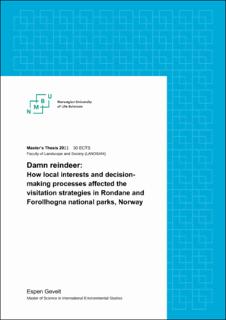| dc.description.abstract | Conservation protects species by regulating human use of areas. As humans are regulated, conflicts occur over the balance between sustainable use and conservation. In 2015, the Norwegian government announced a new branding strategy to improve conserved areas’ abilities to provide income for locals while protecting the nature. The managers of conserved areas should create their own visitation strategy. Rondane and Forollhogna national parks have their own visitation strategies, but these visitation strategies are different, as Rondanes visitation strategy focuses on activities within the national park, while Forollhognas visitation strategy focuses on activities in the border area.
This thesis aimed to understand why these visitation strategies are different and how well these visitation strategies facilitate cooperation between actors. The actors examined were reindeer, local communities, tourist businesses, and farmers. I used discourse and legitimacy theories to systematize and understand the local interests and the creation processes of the visitation strategies. Furthermore, I used these theories to examine how well these visitation strategies facilitate cooperation between actors.
After reading documents from both national parks, and interviewing 32 people, results show that local communities and farmers had similar interests across both national parks. However, while the tourist business in Rondane had interests within the national park, Forollhogna’s tourist businesses had interests in the border area. Since Rondane has a larger number of tourists within the national park, their reindeer situation is more pressing than in Forollhogna. Furthermore, the creation processes were different, where Rondane included a small group of actors, while Forollhogna’s national park board included locals in shaping the visitation strategy.
The studies shows both interests and decision-making processes affected visitation strategies. But furthermore, the national parks characteristics shaped the reindeer situation and tourist businesses. Actors used to cooperate in Rondane, but not today. Forollhogna facilitates cooperation between actors by embracing locals as managers of their conserved area, they also draw tourism to the border area. I conclude Rondane national park board should re-establish cooperation as they once had, and/or strive for cooperation like in Forollhogna. Cooperation can both improve the national park’s ability to protect conservation values, while mitigating the negative consequences conserved areas can have on locals. | en_US |

